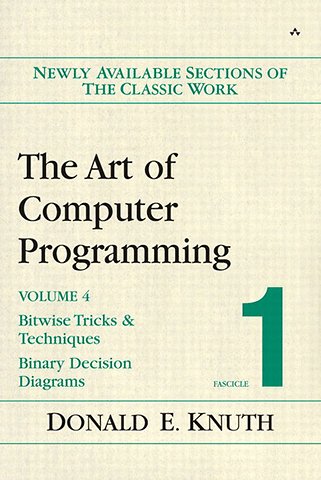


Donald E. Knuth was born on January 10, 1938 in Milwaukee, Wisconsin. He studied mathematics as an undergraduate at Case Institute of Technology, where he also wrote software at the Computing Center.
Meer over Donald KnuthArt of Computer Programming, Volume 4, Fascicle 1, The: Bitwise Tricks & Techniques; Binary Decision Diagrams
Paperback Engels 2009 1e druk 9780321580504Samenvatting
This multivolume work on the analysis of algorithms has long been recognized as the definitive description of classical computer science. The three complete volumes published to date already comprise a unique and invaluable resource in programming theory and practice. Countless readers have spoken about the profound personal influence of Knuth's writings. Scientists have marveled at the beauty and elegance of his analysis, while practicing programmers have successfully applied his "cookbook" solutions to their day-to-day problems. All have admired Knuth for the breadth, clarity, accuracy, and good humor found in his books.
To begin the fourth and later volumes of the set, and to update parts of the existing three, Knuth has created a series of small books called fascicles, which will be published at regular intervals. Each fascicle will encompass a section or more of wholly new or revised material. Ultimately, the content of these fascicles will be rolled up into the comprehensive, final versions of each volume, and the enormous undertaking that began in 1962 will be complete.
Volume 4, Fascicle 1
This fascicle, enlivened by a wealth of Knuth's typically enjoyable examples, describes basic “broadword” operations and an important class of data structures that can make computer programs run dozens–even thousands–of times faster. The author brings together and explains a substantial amount of previously scattered but eminently practical information known only to a few specialists. The book also includes nearly five-hundred exercises for self-study, with detailed answers given in nearly every case; dozens of these exercises present original material that has never before been published. Simply put, this fascicle is a must-have for anybody who is faced with tough problems of a combinatorial flavor. It demonstrates how ordinary programmers can make use of powerful techniques that heretofore seemed to be available only to people who used specialized languages and software. It shows how ideas once thought to be “far out” are now ready to become a part of the programming mainstream.
Specificaties
Lezersrecensies
Inhoudsopgave
7.1 Zeroes and Ones
7.1.1 Boolean Basics
7.1.2 Boolean Evaluation
7.1.3 Bitwise Tricks and Techniques
7.1.4 Binary Decision Diagrams
Answers to Exercises
Index and Glossary
Anderen die dit boek kochten, kochten ook
Rubrieken
- advisering
- algemeen management
- coaching en trainen
- communicatie en media
- economie
- financieel management
- inkoop en logistiek
- internet en social media
- it-management / ict
- juridisch
- leiderschap
- marketing
- mens en maatschappij
- non-profit
- ondernemen
- organisatiekunde
- personal finance
- personeelsmanagement
- persoonlijke effectiviteit
- projectmanagement
- psychologie
- reclame en verkoop
- strategisch management
- verandermanagement
- werk en loopbaan





